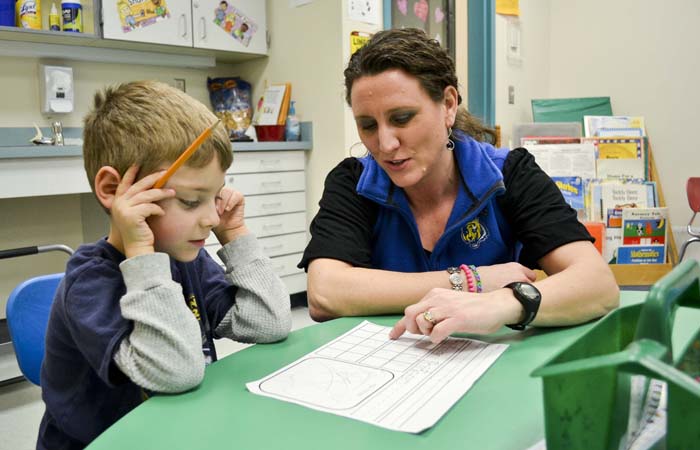Schools planning for students beyond K-12
Published 4:29 pm Thursday, February 5, 2015

- Stanfield preschool teacher Brenna Weyand works with preschool student Johnny Butler Thursday afternoon on a math assignment.
For many schools in the region that started preschool programs in the last few years, the motivation was more than just preparing students for kindergarten.
Many administrators said, by providing preschool and other early-learning opportunities before, they hope to start students on a long-term track for success that will prepare them for opportunities after high school.
STARTING EARLY
Stanfield School District started a 4-year-old preschool program this year, which Superintendent Shelley Liscom said will serve as a starting point for tracking students through the grades and into college.
Starting last year, kindergartners began taking the Kindergarten Readiness Assessment, which tests students on their letter sounds, letter names, numbers and social skills at the beginning of the year to assess what their skills levels were when they started school.
Liscom said district administrators will track this year’s 4-year-olds’ scores and learning performance beginning when they take the KRA next year and will follow those students progress through high school and hopefully into college to see who obtained their goals. Meanwhile, she said, she hopes each of those students will have developed a plan where, with the right scores, grades and opportunities, they will be able to pursue whatever avenue they wish after high school.
“It is all about encouraging kids that it is not about the now,” Liscom said. “It is not about what is happening to you now. It is about what you are building so that when you want to go do something, you can. When you’ve got the grades, the scores or you have the class work or the skills and the ability, then you can go do that, and you don’t have to not choose what you really want to do.”
According to the Northwest Evaluation Association, 98 percent of students in the top 20 percent of second-graders will go on to a four-year university. Of those students in the bottom 10 percent, however, only 12 percent of them will go on to a four-year college.
Liscom said those figures are evidence that early education figures significantly into whether a student will be successful in their later education years.
“One of the hardest things in education is you don’t necessarily see how your work affects children when they are graduating from high school,” she said.
By providing students with options like preschool in the public school setting, the district is allowing students to get a head start on learning they might not otherwise have had, Liscom said. Currently, the Stanfield preschool has 11 students who are working to learn their numbers, letters, sounds and colors, while also familiarizing them with the classroom environment.
The same is happening in Umatilla and Echo with their preschool programs, as well as the once-a-month preschool program that Hermiston offers to its families.
Since Umatilla started its preschool program last year and instituted a partnership program with the rest of the preschools in the region, the district saw increases in student performance across the board, based on data presented from its Kindergarten Readiness Assessment this year, Superintendent Heidi Sipe said.
“One of the things that we noticed is that in each and every category measured this year, we had higher growth than the state average growth,” she said. “We know that our preschool partnerships are definitely having an impact.”
All numbers in Umatilla were also higher than those reported from last year’s kindergarten class. Sipe said she hopes to continue to see numbers increase as the district maintains the preschool options and partnerships available.
“We are always trying to close the gap between our students and the rest of the state,” she said. “If we are still trying to catch up to a higher rate, we know we will have work to do.”
Liscom said that Elgin, which has had a preschool program for a few years now, has KRA data that is well above the state average.
“We are wanting to share the success in the region and then help other districts or other community agencies,” she said. “It’s helping people to replicate what is successful.”
TRAINING FOR TEACHERS
Liscom said one way districts can share their successes is through the Blue Mountain Early Learning hub, which provides training opportunities for teachers and resources for families. Liscom is the current chairman of the hub’s governance board and helps provide direction and policy for the overall program.
“One of our kindergarten teachers, one of our second-grade teachers and our preschool teacher meet with Echo’s kindergarten teacher and preschool teacher once a month to talk about what is working in their classroom and what they need help with,” she said.
Then every couple of months, inservice training opportunities are extended to districts across the region so teachers can meet and talk about what is working and isn’t working overall, she said.




